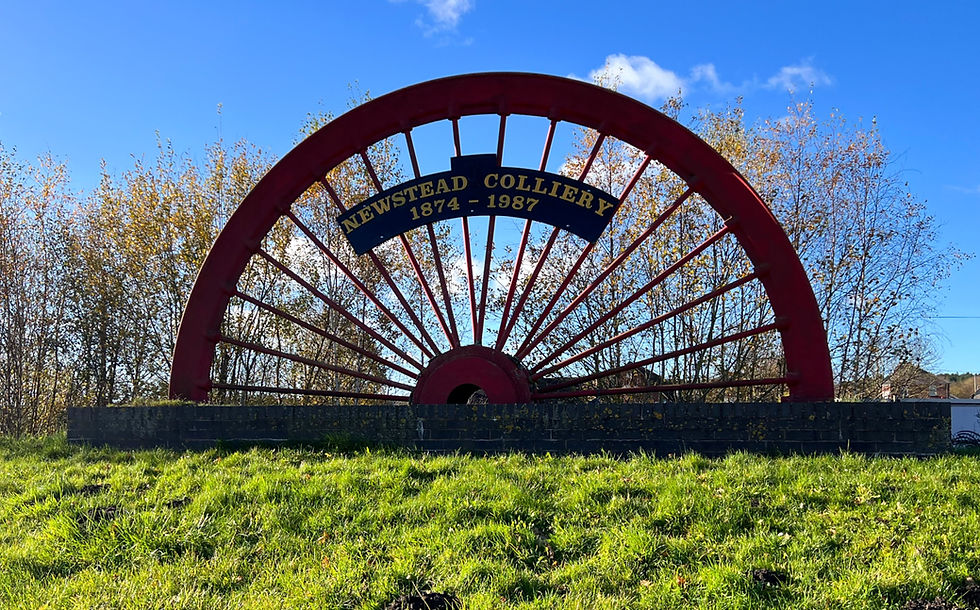Exploring Nottinghamshire's Industrial Heritage
- Tina Brindley
- Nov 17, 2023
- 3 min read
Updated: Nov 20, 2023
Vicar Water Circular Walk. Nottinghamshire Short Walks
A Walk to Vicar Water through Crown Farm and Clipstone Collieries (nature reserves)

Walk type: easy circular walk
Distance: 3.4 miles
Walk time: 1 hour
Total ascent: 240 ft
Highest point: 425 ft
Trigs: 0
Stiles: 3
Nottinghamshire, a county steeped in industrial history, holds the remnants of its coal mining past within its landscapes. Todays exploration takes us on a short walk through the old colliery sites of Crown Farm (Mansfield) Colliery and Clipstone Colliery, heading in the direction of the beauty of Vicar Water. As we traverse the nature reserves, we delve into the rich history of these once-bustling coal mines, each with its own story to tell.
Crown Farm Colliery

Our journey begins at Crown Farm Industrial estate,
where I parked the car: ///privately.purple.river
In 1904, Crown Farm Colliery, also known as Crownie Colliery, quickly became synonymous with coal production, gaining a reputation as one of the largest mines in the country during its early years. The proximity to the farm after which it was named gives it a distinctive charm. Despite being closed in 1988, surpassing its initial estimated lifespan of 50 years, Crown Farm Colliery left behind a unique legacy. The old pit tip was transformed into a thriving nature reserve, showcasing nature's resilience amidst the remnants of the industrial era. As we walk through this industrial-turned-natural landscape, the contrast between past and present becomes palpable. The difference in the landscape from my days playing as a child with a backdrop of big black pit tips and coal fired chimneys belching out black smock to present day as a 60 year old walking on the same pit tip cover in trees and bushes with birds of pray flying above me head.
Clipstone Colliery

Continuing our journey, we make our way towards Clipstone Colliery, nestled in the village of Clipstone within the famed Dukeries region. The colliery, operational from 1922 to 2003, bears witness to the transitions in ownership from the Bolsover Colliery Company to the National Coal Board and eventually RJB Mining in 1994. The towering headstocks of Clipstone Colliery, standing at 214 feet, serve as sentinels of the past, dominating the skyline and preserving the memory of a once-thriving industry. The two deep shafts, reaching 1,006 yards into the earth, are a testament to the engineering marvels of their time. Despite the closure, the headstocks endure, a symbol of resilience and a reminder of the hardworking communities that once relied on these mines.
Vicar Water

As our walk continues, we find ourselves at the picturesque Vicar Water.
Vicar Water country park (NG21 9AA) is just to the south of Clipstone village. It has been created on the site of a former colliery, transforming this former industrial site into a heathland, woodland and grassland.
The 5th Duke of Portland constructed a dam across the river in the 1870s, to impound the water and create a lake. The name of the river was Warmebroke at that time, and it was not called Vicar Water until the early nineteenth century, It was used as a trout fishery, from which the lakes at Welbeck Abbey were stocked. Records show that 600 fish were transferred in 1873.
Thirty years later, the pool was a popular location for swimming and boating. It continued to be so during the First World War, when it was used by some of the 20,000 soldiers stationed nearby, and after the opening of Clipstone Colliery in 1922, numbers using the facilities were swelled by some of the 2,000 residents who moved into the purpose-built village of New Clipstone. Fishing also became popular, with the Duke awarding the fishing rights to the Clipstone Colliery Angling Club. but Spoil tips from the mine gradually surrounded the lake and river, until tipping ceased in 1976. Nottinghamshire County Council then initiated a reclamation scheme, to transform the area into a country park. 25 acres (10 ha) of woodland were planted, and the park opened in 1982.

The headstocks of Clipstone Colliery stand proudly in the distance, as a reminder.
Our short walk through Nottinghamshire's industrial history, from Crown Farm Colliery to Clipstone Colliery, serves as a poignant reminder of the region's coal mining legacy. The transformation of former colliery sites into industrial estates and nature reserves symbolizes the resilience of nature and the adaptability of the communities.
As we stand at Vicar Water, we reflect on the importance of preserving these historical sites, ensuring that the stories of the past continue to resonate with future generations.
The last bit of the walk follows the river back towards more fishing lakes, you can't see the river on this stretch as it is under ground. but before we do the last bit lets pop in to the cafe.

We are now back to where we started our walk and the car.
if you would like to do this walk the link to the map is blow the video






Comments